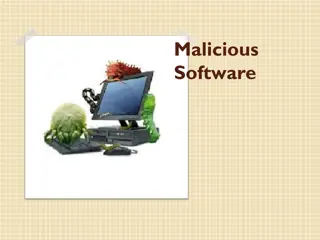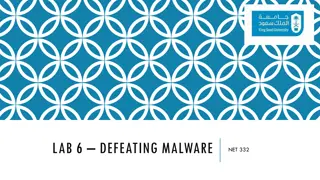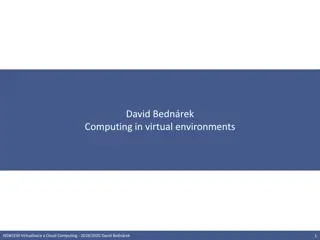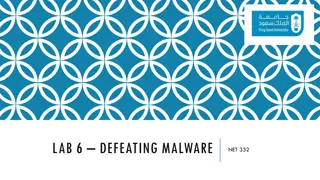Cloaking Malware with Trusted Platform Module in Secure Computing Environments
Exploring the concept of using Trusted Platform Modules (TPM) for cloaking malware to achieve secure and hidden computations. This research delves into leveraging hardware-based security features to execute and safeguard malicious code, highlighting the potential threats and implications within secure computing environments.
Download Presentation

Please find below an Image/Link to download the presentation.
The content on the website is provided AS IS for your information and personal use only. It may not be sold, licensed, or shared on other websites without obtaining consent from the author.If you encounter any issues during the download, it is possible that the publisher has removed the file from their server.
You are allowed to download the files provided on this website for personal or commercial use, subject to the condition that they are used lawfully. All files are the property of their respective owners.
The content on the website is provided AS IS for your information and personal use only. It may not be sold, licensed, or shared on other websites without obtaining consent from the author.
E N D
Presentation Transcript
Cloaking Malware with the Trusted Platform Module Alan Dunn, Owen Hofmann, Brent Waters, Emmett Witchel University of Texas at Austin USENIX Security August 12, 2011
Trusted Computing Goal: Secure environment for computation Trust rooted in hardware Most familiar: Trusted Platform Module (TPM) Standard by Trusted Computing Group (TCG) IC in x86 machines connected to southbridge Widely deployed (> 350 million TPMs)
Uses of Trusted Computing Typical: TPM provides hardware root of trust Store cryptographic hash of executed software Perform cryptography, store secret keys Provide hardware-protected execution environment Ours: TPM provides hardware cloak for malware Only run unmodified malware Store malware secret keys No monitoring/debuggers/virtualization
Conficker B Explanation Conficker B Analysis ! get_updates() gen_domains() date = get_date_from_web() calculate domains 8/13/11 8/12/11 www.google.com Secure date mechanism Contact websites aijuer.com lkpexhjz.org environment TPM can help malware writers achieve this goal: Execute computation securely in non-analyzable for domain in domains: content = fetch_content(domains) if (check_sig(content)) apply_update(content) Goal for malware writers: Secure and hidden malware sub- computation
Outline Protocol Overview Protocol Implementation Defenses
Protocol Overview Infected Platform Malware Distribution Platform (MDP) main() sensitive_calc() sensitive_calc() normal_calc() Put platform in known non- analyzable state Restrict payload decryption to non-analyzable state Infection Payload Loader Late launch environment
Put platform in non-analyzable state Suspend all system software, jump into known software state Late launch performs jump, records program jumped to via hash Infected Platform Infection Payload Loader Late launch environment
Restricting payload decryption TPM controls private key use for keypairs it generates Binding key constrained to use in non-analyzable state Certificates show Endorsement Key (EK) belongs to legitimate TPM Remote attestation proves binding key generated by same party as EK, so payload only decryptable in late launch Malware Distribution Platform (MDP) Infected Platform Binding key Malicious payload
Late Launch SENTER instruction transfers control to binary, sets TPM register based upon cryptographic hash of binary Allows binary to execute securely: stop other cores, turn off interrupts For malware: Transfer control to Infection Payload Loader (IPL) IPL hash satisfies key use constraint IPL decrypts, transfers control to malicious payload
Validating the Binding Key Endorsement Key (EK) unique identifying key, certified by TPM manufacturer Sign binding key with EK? Forbidden! EK identifying, compromises anonymity Sign(EK, M1) P1 Correlate transactions A P2 Sign(EK, M2)
TPM Identity (EK) with Indirection (AIK) Attestation Identity Keys (AIKs) fix anonymity Privacy CA vouches that AIK represents EK Problem: Privacy CAs don t exist Solution: Malware Distribution Platform acts as Privacy CA Establish EK legitimacy, AIKs proxy for EK Sign(AIK1, M1) P1 C vouches for legitimacy of AIKs A C P2 Sign(AIK2, M2) C is a Privacy CA
Can malware generate an AIK? Owner AuthData required for AIK generation Owner AuthData not needed on platform, used rarely Capture from keylogging or from memory (Windows: cached for days)
Remote attestation details Infected Platform Malware Distribution Platform (MDP) Phase 1: cred AIKrepresents EK 1) Generate AIK 2) PKEK, PKAIK, Sign(SKmanuf.,H(PKEK)) 3) Verify EK sig 4) Enc(PKEK, cred || H(PKAIK)) 5) Activate AIK: if H(PKAIK) matches AIK generated on that platform, TPM releases cred
Remote attestation details (contd) Infected Platform Malware Distribution Platform (MDP) Phase 2: Prove binding key is from TPM that controls EK 1) Generate binding key with use constraint 2) PKbind, key use constraint, cred, Sign(SKAIK,H(PKbind||key use constraint)) 3) Verify use constraint, cred 4) Send encrypted malicious payload 5) Late launch, decrypt and run payload Malicious payload
Implementation Protocol until late launch (w/TrouSerS) Late launch (via Flicker v0.2) on Intel platforms Infection Payload Loader (IPL): decrypt, execute payload IPL run appears as 3 second system freeze on Infected Platform due to TPM key operations in late launch Three malicious payloads Conficker B-like example Secure time via Ubuntu package manifests DDoS timebomb Secret text search
Defense: Whitelisting late launch binaries Hypervisor-level whitelisting Trap on SENTER, check late launch binary List of hashes of whitelisted binaries Digitally sign binaries, whitelist signing keys Problems Requires hypervisor: tough for home users Late launch binary updates Signatures: Revocation, trust management (certificate chains)
Defense: Manufacturer Cooperation Manufacturer breaks TPM guarantees for analyst Fake Endorsement Key (EK) Manufacturer produces certificate for EK that is not TPM controlled Problem: EK leak can compromise TPM security properties Fake Attestation Identity Key (AIK) Manufacturer uses EK to complete AIK activation for AIK that is not TPM controlled Problem: AIK requests need manufacturer response online
Defense: Physical Compromises TPM compromise has been demonstrated Simple: Grounding LPC bus allowed faking of TPM code measurement Exotic: Etching away casing, probing around tamper-resistant wiring allowed EK recovery Industry incentives to fix Further discussion in paper (e.g. cold boot)
Conclusion TPM can cloak malware sub-computations, hiding them from analysts Concrete implementation of TPM-based malware cloaking Remote attestation Late launch Strengthening TPM guarantees makes attack more resilient























